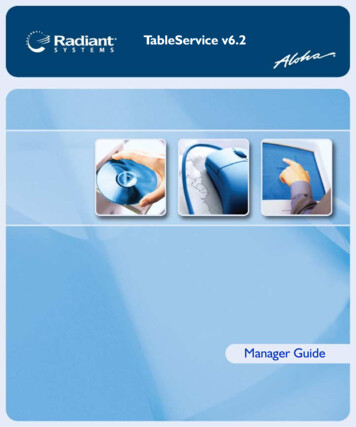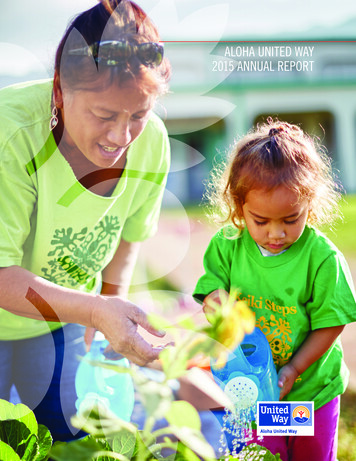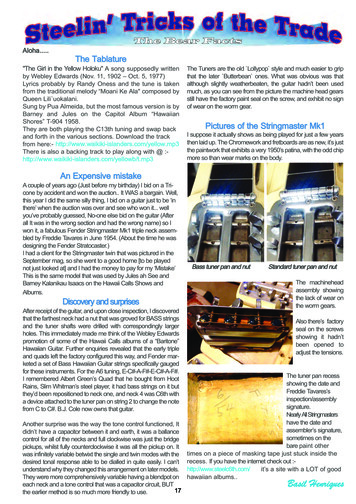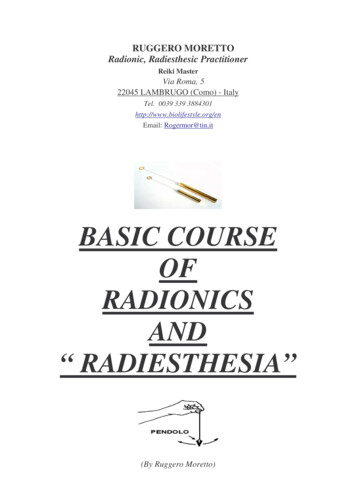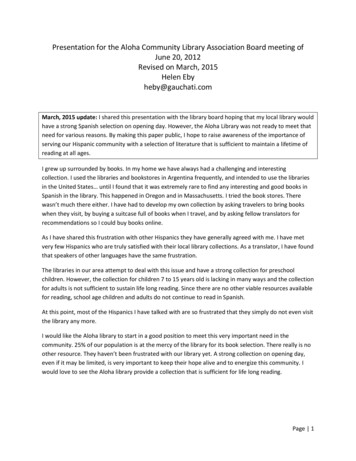
Transcription
Presentation for the Aloha Community Library Association Board meeting ofJune 20, 2012Revised on March, 2015Helen Ebyheby@gauchati.comMarch, 2015 update: I shared this presentation with the library board hoping that my local library wouldhave a strong Spanish selection on opening day. However, the Aloha Library was not ready to meet thatneed for various reasons. By making this paper public, I hope to raise awareness of the importance ofserving our Hispanic community with a selection of literature that is sufficient to maintain a lifetime ofreading at all ages.I grew up surrounded by books. In my home we have always had a challenging and interestingcollection. I used the libraries and bookstores in Argentina frequently, and intended to use the librariesin the United States until I found that it was extremely rare to find any interesting and good books inSpanish in the library. This happened in Oregon and in Massachusetts. I tried the book stores. Therewasn’t much there either. I have had to develop my own collection by asking travelers to bring bookswhen they visit, by buying a suitcase full of books when I travel, and by asking fellow translators forrecommendations so I could buy books online.As I have shared this frustration with other Hispanics they have generally agreed with me. I have metvery few Hispanics who are truly satisfied with their local library collections. As a translator, I have foundthat speakers of other languages have the same frustration.The libraries in our area attempt to deal with this issue and have a strong collection for preschoolchildren. However, the collection for children 7 to 15 years old is lacking in many ways and the collectionfor adults is not sufficient to sustain life long reading. Since there are no other viable resources availablefor reading, school age children and adults do not continue to read in Spanish.At this point, most of the Hispanics I have talked with are so frustrated that they simply do not even visitthe library any more.I would like the Aloha library to start in a good position to meet this very important need in thecommunity. 25% of our population is at the mercy of the library for its book selection. There really is noother resource. They haven’t been frustrated with our library yet. A strong collection on opening day,even if it may be limited, is very important to keep their hope alive and to energize this community. Iwould love to see the Aloha library provide a collection that is sufficient for life long reading.Page 1
My backgroundI learned how to read in Spanish before I started kindergarten in Newtown, PA. My mother’s family hasimportant ties to the history of Argentina, where I lived from the time I was 8 until I was 28. Then I spent15 months visiting almost all countries of Latin America.I have served the Hispanic community in the US as a freelance translator and interpreter for about 15years. I have met a wide variety of people with limited English skills and have talked with them abouttheir situations many times.I volunteer with my church, and we have developed several programs: We have a vibrant English as a Second Language (ESL) program, and several students have leftthe classes because they are now able to work at a job.We have been providing books for children in Woodburn for years. Last year we gave a daycarecenter 200 of books for children, so they could check them out and send them home onweekends as well as read them on site. This year we are donating 500 of books for the project.These have been very effective.We have a series of culture conversations on an almost monthly basis at the day care center.Every month we cover a different topic about how to adjust to living in the United States.Members of both cultures participate in the conversation, and both groups have grown inunderstanding and friendship. Both groups want to keep the series going.In the translation community, I have been nominated as Assistant Administrator of the Spanish divisionof the American Translators Association, partly because I suggest creative solutions to problems andencourage others to serve their community. I think translators and interpreters are uniquely qualified tobridge the culture gap and help both sides of the community engage with each other because weunderstand both sides very deeply.Page 2
Spanish community:63% of the Hispanic population in the Oregon is Mexican. Nationally, over 50% of this group hascompleted 9th grade, and in the second generation the percentage of people who go to school after highschool is 44%. This segment of the population truly encourages education in their children.The poverty level of Mexicans in the United States is 22.1% to 23.3%. In 2010, the national percentagewas 15.1%.According to the US Census, the Hispanic population of the United States is composed of the followinggroups. Our collection should reflect this type of diversity, with representative authors from theseregions.Mexican63%Puerto Rican9.2%Cuban3.5%Other Hispanics24.3%Dominican Republic2.8%Population of Mexican origin that resides in the United StatesCharacteristicsFirst generationSchoolingUp to 9th grade49.5 %10 to 12 grades35.2 %Comm. College9.3 %Bachelors and grad school5.9 %Poverty levelPoor22.1 %Not poor77.9 %First generationSecond generationThird generation14.0 %41.7 %28.7 %15.6 %13.3 %45.2 %28.4 %13.2 %23.3 %76.7 %19.3 %80.7 %Second generationUp to 9th gradeUp to 9th grade10 to 12 grades10 to 12 gradesComm. CollegeComm. CollegeBachelors andgrad schoolBachelors andgrad schoolSource: Estimates of CONAPO based on the Bureau of Census, Current Population Survey (CPS), Marchof 2000, 2002, 2004, 2006 and 2007.Page 3
Survey:We have surveyed the Hispanic community in Aloha, and here are some of the highlights of what theywant in a library: Spanish books (quality literature originally written in Spanish, new books for all ages)Spanish helpersInterests:o historyo scienceo classicso childreno how to help children in schoolo how to raise teenagerso healtho self-improvemento how to overcome depressiono volunteeringo books in English and in Spanish for teensESLHomework supportBook club for Hispanic adolescents, so they can continue to develop their Spanish languageskills. They want to grow in this area, but the school curriculum didn’t meet the perceived needsof one teenager I spoke to. Other parents told me their children are no longer bilingual enoughto read Spanish books. The library could make a significant difference here. These are the trulybilingual people of the future, and we can’t afford to lose them.I believe depression is a real issue in the Hispanic community, triggered in part by the very largeseparation between Hispanics and non-Hispanics. The library could be a place of healing throughbooks and the opportunity to be truly involved in the community, working side by side as neighbors ina context of mutual respect that is not marred by politics. This sense of community will also helpteens as they grow up. This hope is shared by others in the community.Page 4
Some stories: A woman approached me at the health fair and told me that she came to the United States tohelp her son focus on his college studies. To do so, she left a successful career as a nursingsupervisor at a hospital in Venezuela. Today, she works as a cleaning lady because of her lack ofEnglish skills. She wants to work on her ESL education.As I was waiting to start an interpreting session for Hispanics in the Forest Grove school district,a Mexican woman approached me and told me her Spanish used to be as good as mine.However, since the library has not provided the quality of interesting books she needs, she hasnot read consistently in the last 15 years she has been here, and her literacy level hasdiminished significantly from her time in Mexico as executive secretary.Another woman who I met at the health fair has stage 4 breast cancer and came to the US fortreatment. Her 11-year-old son is extremely bright, and they haven’t found any books that havebeen appropriate to keep him challenged. They left with a very big smile when I loaned themthree books.Maria, one of my ESL students in Woodburn, is an extremely dedicated woman. After coming toESL for a year and a half, she spoke to me about increasing her Spanish literacy level. She onlyhad access to school until 4th grade, and she wants to increase it so she can also approachEnglish more effectively.Hispanics in the professional world also like to relax by playing Spanish music, eating Spanishfood and reading Spanish books. It is part of who we are, and we need this.Everywhere I go, as soon as I approach Hispanics and ask them if they are interested in a library withquality books, they are interested. When I show my samples of what good books look like, they want tostart borrowing them immediately, and ask “Where do you get this?” My answer: in Argentina, or in mytravels.We are a team.Though I refer to myself, we are working as a team. I have talked with the librarian in our Library Boardto learn from her and align our collection policies for the Hispanic community with the general policiesof the ACLA, while being faithful to meet the needs of the community. Based on this, we will focus ongood quality books in near new condition.Others from the Hispanic community have joined with me to form a team and select books. I haveassigned sections of 100 books of the catalog to different people, and we will be ready to present a listof desired books by early August. I also have asked members of the Woodburn community for theirinput, and have their priorities. As our team develops a shopping list from our catalogs, we learn what isof interest to the community.Page 5
We will focus on literature for the different age groups.Preschoolers. The libraries in Shute Park and Forest Grove have strong collections, and we can learnfrom them.Young readers: We need a combination of translations of books popular in the US and books originallywritten in Spanish, leaning towards a 40% translated from English and 60% originally in Spanish. I spokewith the Children’s librarian in Forest Grove, and she observed that these translated books are oftenchecked out by parents who want to know what their children are reading in English. This is animportant service.Adults: This needs to include books by popular authors of all Latin America including Mexico. Somesuggestions made by Elizabeth Lopez, the Spanish librarian in Hillsboro, are authors Carlos CuauhtémocSánchez and Cesar Lozano, and books related to celebrities, such as La Reina del Sur, by Dr. Ana MariaPolo (biography of Selena).Practical steps we can take as a library:I believe it is important to have a strong collection and a visible commitment to Spanish literature fromthe first day. I would like to see a certain area of shelves designated for Spanish books, even if they arestill empty, in the library on opening day. They could have a sign saying something like: “Future home ofthe Spanish collection – to help us reach this goal, please donate to the library. Books cost an average of 20.”On June 30 I met with Hispanics to choose books, at my home. Three members of the community cameto help. We established a process to choose books, talked about fundraising, and expect to have apreliminary selection of books made in a month. We began with the Alfaguara/Santillana children’s andadult literature collections.I have the full catalogs of Alfaguara (560 titles for youth and 1183 titles for adults) and the Fondo deCultura Económico (2289 titles). Alfaguara specializes in literature for all ages, and is one of the largestSpanish language publishing houses. FCE specializes in making the Spanish culture accessible andaffordable and has offered a 50% discount on all our purchases.In early August we will be able to shop from these catalogs, based on available funds and teamselection. I would like to recommend that the Board authorize an expenditure of 1500 for thiscollection.We can start to collect Spanish books and funds from the community. I would like to place bookdonation boxes in the places where Hispanics meet. Initially, we could placing them in churches andgrocery stores that cater to Hispanics. These boxes could have a slot on the side for people to take a flierhome with information on how to make a donation to the library for our collections. I would stronglyencourage donations of multiples of 20, since I estimate that would be the average cost of a book oncewe include shipping, processing, and other incidentals. I recommend that the Board authorize thePage 6
creation of a fund based on donations designated for Spanish books. This information would befeatured in the flier that goes with the book donation boxes.I have two shopping trips planned in conjunction with translation conventions. This will allow me tochoose quality picture books for children and fill in some other gaps in our collection. I will also keep aneye out to support the other local libraries. The largest Spanish book fair in the world, in Guadalajara, Mexico, on Thanksgivingweekend. This fair happens in connection with one of the best translator conventions inMexico, and lodging for the translators is sponsored by the book fair. I plan to be there and shop for the library.The Fondo de Cultura Económico has a branch office in San Diego. They are offering a50% discount. I will be there in the end of October for an ATA convention.Spanish poetry and humor have their own special flavor. I have attempted to translate one of myfavorite poems, by Gustavo Adolfo Bécquer. He lived in Seville from 1836 to 1870 and is a favorite in theentire Spanish-speaking world. This poem reminds me of the value of those we have neglected andignored not just within the Hispanic community! I think this applies to any human being.Del salón en el ángulo oscuro,de su dueño tal vez olvidada,silenciosa y cubierta de polvoveíase el arpa.In a dark cor
20.06.2012 · Sánchez and Cesar Lozano, and books related to celebrities, such as La Reina del Sur, by Dr. Ana Maria Polo (biography of Selena). Practical steps we can take as a library: I believe it is important to have a strong collection and a visible commitment to Spanish literature from the first day. I would like to see a certain area of shelves designated for Spanish books, even if they are – .




